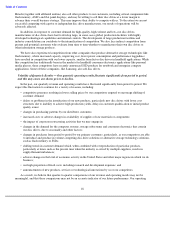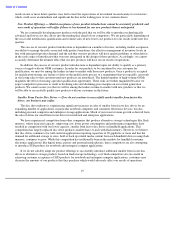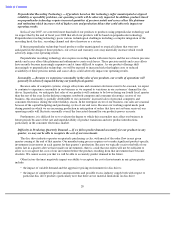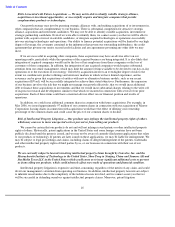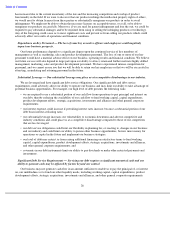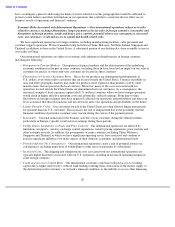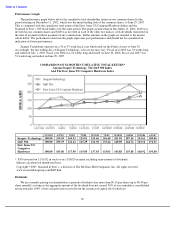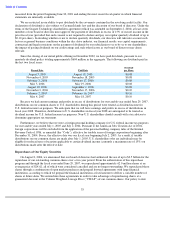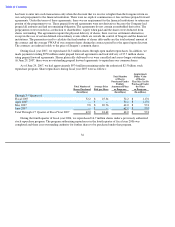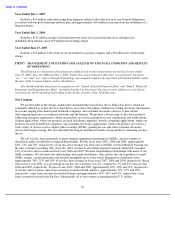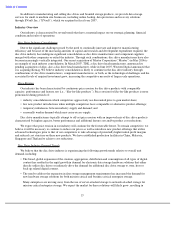Seagate 2006 Annual Report Download - page 31
Download and view the complete annual report
Please find page 31 of the 2006 Seagate annual report below. You can navigate through the pages in the report by either clicking on the pages listed below, or by using the keyword search tool below to find specific information within the annual report.
Table of Contents
have a contingency plan for addressing the kinds of events referred to in this paragraph that would be sufficient to
prevent system failures and other interruptions in our operations that could have a material adverse effect on our
business, results of operations and financial condition.
Economic Risks Associated with International Operations — Our international operations subject us to risks
related to currency exchange fluctuations, longer payment cycles for sales in foreign countries, seasonality and
disruptions in foreign markets, tariffs and duties, price controls, potential adverse tax consequences, increased
costs, our customers’ credit and access to capital and health-related risks.
We have significant operations in foreign countries, including manufacturing facilities, sales personnel and
customer support operations. We have manufacturing facilities in China, Malaysia, Northern Ireland, Singapore and
Thailand, in addition to those in the United States. A substantial portion of our desktop disc drive assembly occurs in
our facility in China.
Our international operations are subject to economic risks inherent in doing business in foreign countries,
including the following:
28
•
Disruptions in Foreign Markets.
Disruptions in financial markets and the deterioration of the underlying
economic conditions in the past in some countries, including those in Asia, have had an impact on our sales to
customers located in, or whose end
-
user customers are located in, these countries.
•
Fluctuations in Currency Exchange Rates.
Prices for our products are denominated predominately in
U.S. dollars, even when sold to customers that are located outside the United States. Currency instability in
Asia and other geographic markets may make our products more expensive than products sold by other
manufacturers that are priced in the local currency. Moreover, many of the costs associated with our
operations located outside the United States are denominated in local currencies. As a consequence, the
increased strength of local currencies against the U.S. dollar in countries where we have foreign operations
would result in higher effective operating costs and, potentially, reduced earnings. From time to time,
fluctuations in foreign exchange rates have negatively affected our operations and profitability and there can
be no assurance that these fluctuations will not adversely affect our operations and profitability in the future.
•
Longer Payment Cycles.
Our customers outside of the United States are often allowed longer time periods
for payment than our U.S. customers. This increases the risk of nonpayment due to the possibility that the
financial condition of particular customers may worsen during the course of the payment period.
• Seasonality. Seasonal reductions in the business activities of our customers during the summer months,
particularly in Europe, typically result in lower earnings during those periods.
• Tariffs, Duties, Limitations on Trade and Price Controls. Our international operations are affected by
limitations on imports, currency exchange control regulations, transfer pricing regulations, price controls and
other restraints on trade. In addition, the governments of many countries, including China, Malaysia,
Singapore and Thailand, in which we have significant operating assets, have exercised and continue to
exercise significant influence over many aspects of their domestic economies and international trade.
•
Potential Adverse Tax Consequences.
Our international operations create a risk of potential adverse tax
consequences, including imposition of withholding or other taxes on payments by subsidiaries.
•
Increased Costs.
The shipping and transportation costs associated with our international operations are
typically higher than those associated with our U.S. operations, resulting in decreased operating margins in
some foreign countries.
• Credit and Access to Capital Risks. Our international customers could have reduced access to working
capital due to higher interest rates, reduced bank lending resulting from contractions in the money supply or
the deterioration in the customer
’
s or its bank
’
s financial condition, or the inability to access other financing.


